This week’s art picks include drawings that explore deaf rage and experiences of trauma; a new age radio station broadcasting from a Santa Monica gallery; and a series of irregularly shaped paintings that embed found objects on their surfaces.
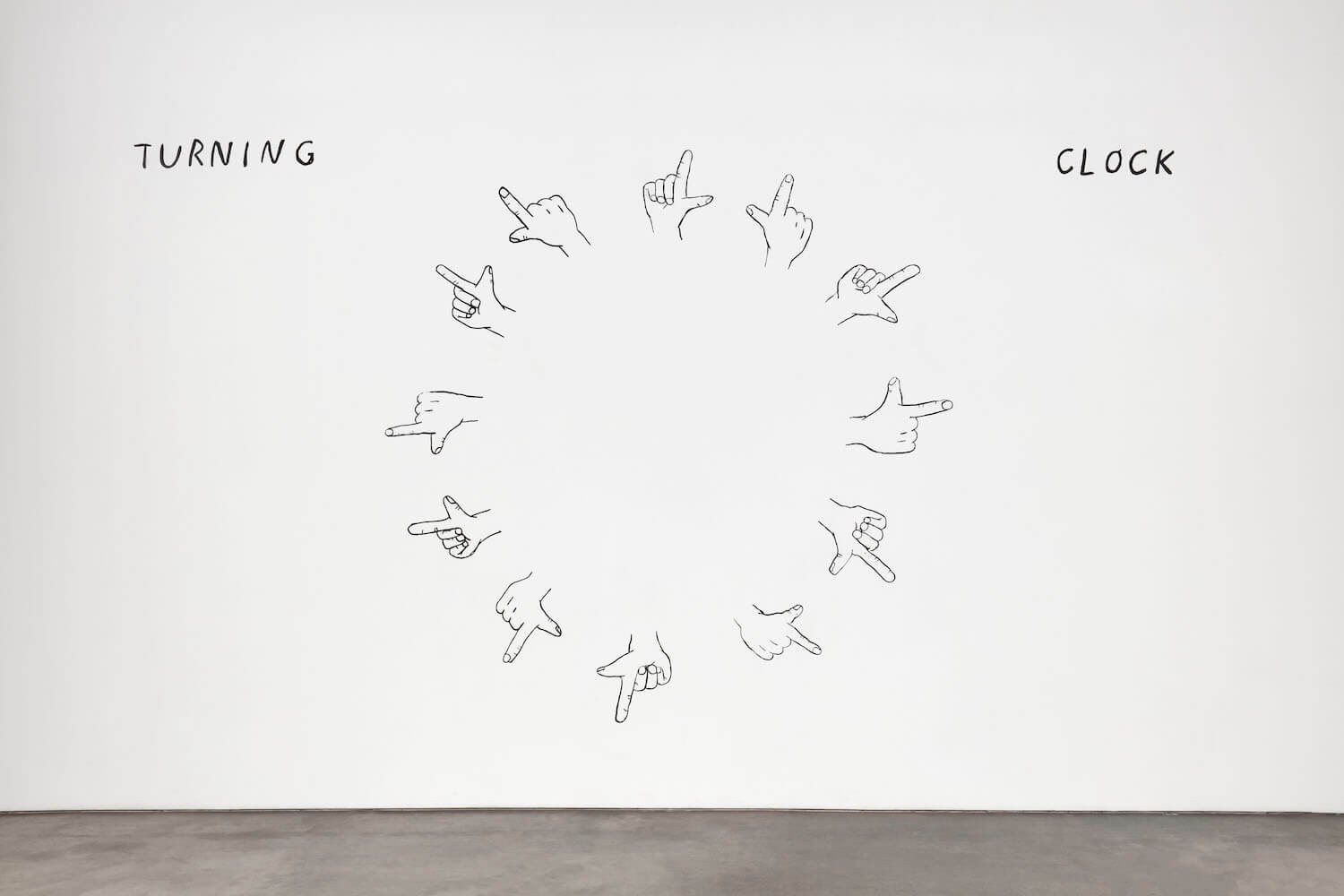
Christine Sun Kim, “Turning Clock,” 2020. Mural, Edition 1 of 3, 1AP, Dimensions adaptable 136 x 240 inches. Image courtesy of the artist and François Ghebaly, Los Angeles. Photo by Paul Salveson.
This is the last week to view Christine Sun Kim’s exhibition of drawings at François Ghebaly downtown. Though this exhibition focuses on drawings, Kim is a multi-disciplinary artist who works in drawing, performance, and sound. Kim was born deaf, and this exhibition titled “Trauma, LOL,” blends communication modes of ASL, infographics, feeling charts, clocks, and musical notation to create works that communicate an array of ideas as well as various obstacles that are faced by the deaf community. One pair of drawings focuses on Kim’s experience signing America the Beautiful and the National Anthem at the 2020 Superbowl, a momentous moment for the ASL community which was not fully televised on Fox Sports and other platforms when the game aired, leading to an op-ed piece by Kim in the New York Times the next day in which she expressed her frustration. The drawings detail some of Kim’s notations in preparing for the performance, as well as the racist and violent undertones in the “Star-Spangled Banner” poem by Francis Scott Key (the national anthem only uses the first stanza of the four in the poem). Elsewhere in the exhibition, the drawing “Deaf Traumas” depicts a ring of smiley faces that move from happy to sad while text around each notates a different social interaction. Throughout the drawing, Kim muses on various oppressions and microaggressions that can occur among the Deaf community, such as “white Deaf on immigrant Deaf,” which is written under a sad face. In “World Clock,” a large mural installed on the gallery wall, the hand sign which means “your turn” in ASL — a pointing hand with the thumb extended — rotates around in a circular pattern, signaling a collective cooperation in which we all must take turns. As such, while rooted in her personal experience, Kim’s exhibition explores a cohesive and universal sentiment of unity — bringing to mind the Martin Luther King Jr. quote, “none of us are free until all of us are free.”
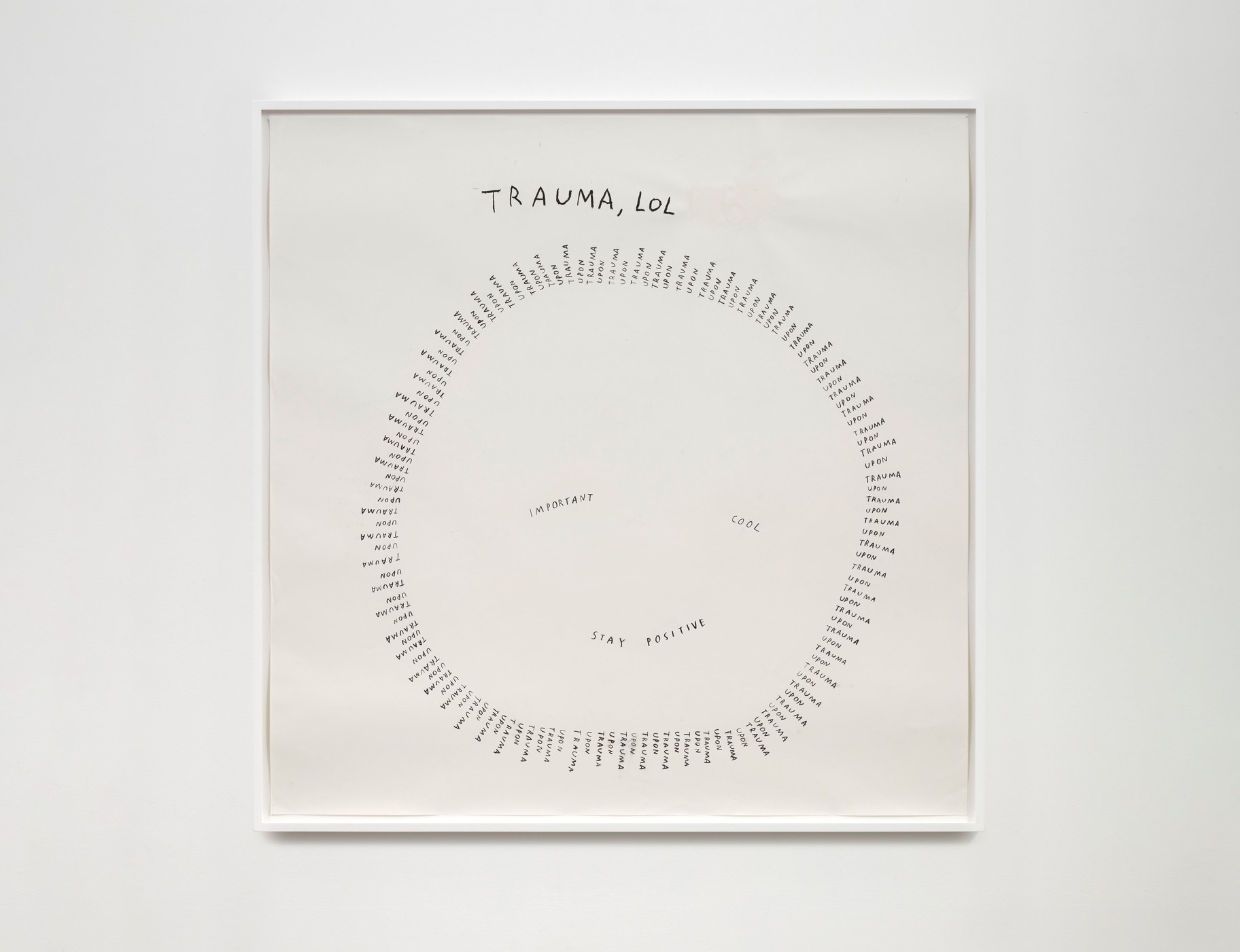
Christine Sun Kim, “Trauma, LOL” (2020). Charcoal on paper, 58.25 x 58.25 inches. Image courtesy of the artist and François Ghebaly, Los Angeles. Photo by Paul Salveson.
Within the themes of trauma, inequality, and oppression present in Christine Sun Kim’s exhibition, a sly humor runs through the show. Kim explained in a recent gallery talk that when she began to interact more regularly in hearing communities, she often turned to humor as a way to connect with others, and this strategy also plays out in her approach to artmaking. “Humor puts people at ease, so I wasn’t so serious,” she explained through an ASL interpreter. “People feel much more comfortable when there’s a little humor involved…My work tends to be a little heavy. I don’t want to alienate people looking at my work…I can layer the heaviness with humor for audiences to connect with as a point of entry. Then they can start to really understand where I am coming from.” In the title work, “Trauma, LOL,” the words “trauma upon trauma upon trauma” continue in an endless loop, while in the middle the words “important, cool, stay positive” form the eyes and mouth of a smiley face. Kim described that the work has to do with repetitive and layered traumas that aren’t easily physicalized and hard to communicate. Kim’s response to these stacked instances of traumas experienced in everyday life is often an attempt to laugh it off or stay positive. She said, “It’s kind of my coping mechanism to being shell-shocked from trauma.”
On view: December 12, 2020 – January 23, 2021
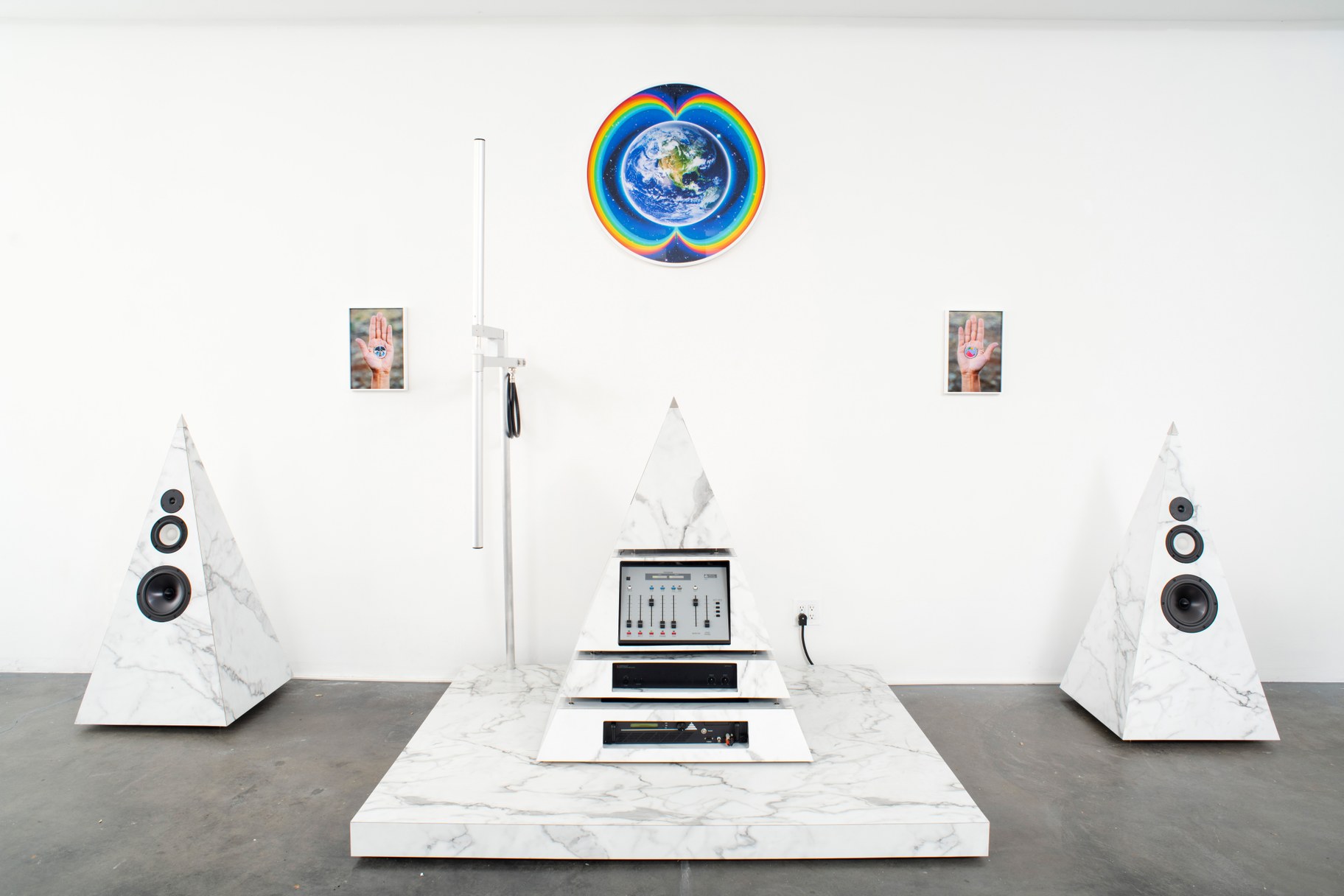
Ian James, “KHLZ: The Rainbow Bridge (FM Radio Station),” 2020. FM Transmitter, RF cable, antenna, amplifier, mixer, microphones, headphones, monitor speakers, speaker wire, stainless steel, calacatta marble laminate, platform, 12 x 6 feet. Image courtesy of the artist and Five Car Garage.
Walking up to Five Car Garage (a gallery in a literal Five Car Garage in Santa Monica), soothing music can be heard emanating from within. The musical frequency, which the artist Ian James refers to as “healing waves” are in fact being broadcasted at short range around the gallery via his sculptural FM radio, “KHLZ: The Rainbow Bridge (FM Radio Station).” After the show, which is titled “The Harmony of the Noosphere,” this functional work will move to a mobile facility in the desert where it will “broadcast Noosphere-encouraging vibrational waves in perpetuity.” Aside from the radio, the exhibition includes photographic and mixed media works that explore the theoretical idea of the Noosphere, imagined by writer Jose Argüelles as a third sphere surrounding the Earth wherein all intelligence on the planet congregates. Images across the work picture product-type shots of models interacting with strange technological devices, presumably, ones that tout or promote some healing attributes. The exhibition approaches new age healing with a mix of sincerity and skepticism, delving into the marketing and capitalism that is present in the industry alongside the holistic unity that can be found in healing practices. The radio station can also be listened to via a link on the gallery’s website, which I listened to this week as a gentle salve to contrast the impeachment hearings.
On view: December 12, 2020 – January 23, 2021
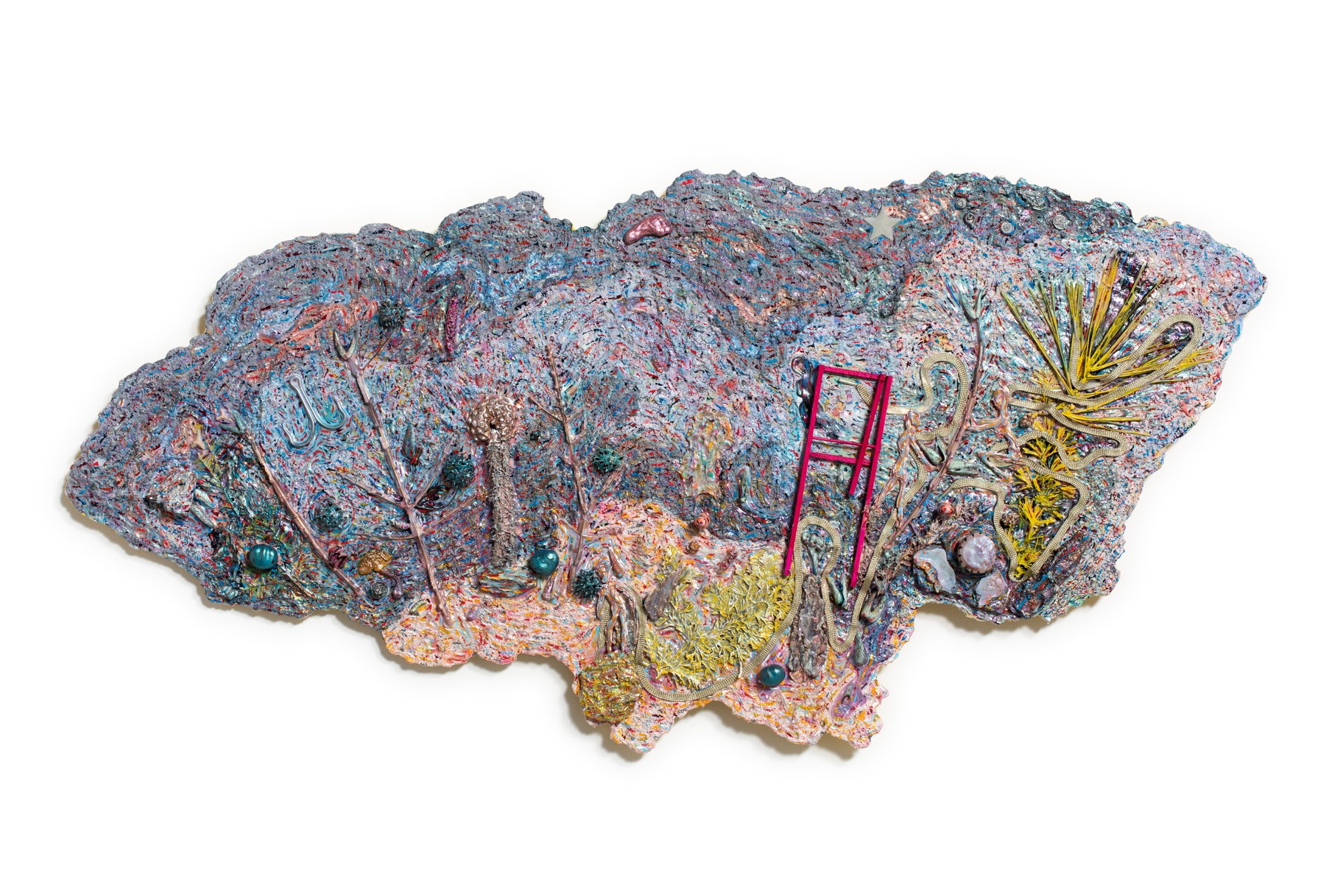
Ye Qin Zhu, “cosmic reach for protection,” 2020. Mixed media on panel, 51 x 24 1/4 x 3 1/2 inches. Image courtesy of the artist and Moskowitz Bayse.
At Moskowitz Bayse in Hollywood, irregularly shaped wood panels form the bases for a wild set of colorful paintings by Ye Qin Zhu. Zhu builds his surfaces slowly to create texturally evocative spaces — some recall some kind of sticky alien plasma while others feel more dull and benign like paper pulp — before applying a final layer of small brush marks that create frenetic fields across each piece. Some, like “cosmic reach for protection” appear as landscapes — brush marks celestially swirling in the sky like Van Gogh’s “Starry Night.” A gold chain is applied to the surface of the work like a slithering snake making her way through the landscape. Other compositions are more abstract, and cell phone covers, beaded jewelry, and other bits and bobs congregate with natural materials like seed pods, becoming entrenched and buried within a field of technicolor dash marks. The titles for these textured panels, such as “merciful river body” or “cosmic reach for protection” add a mystical and spiritual context to the paintings, further transforming the work’s cloaked everyday objects into ritual objects. Here paint becomes a metaphorical medium that can create transformative effects, both physical and spiritual.
On view: January 9–February 6, 2021
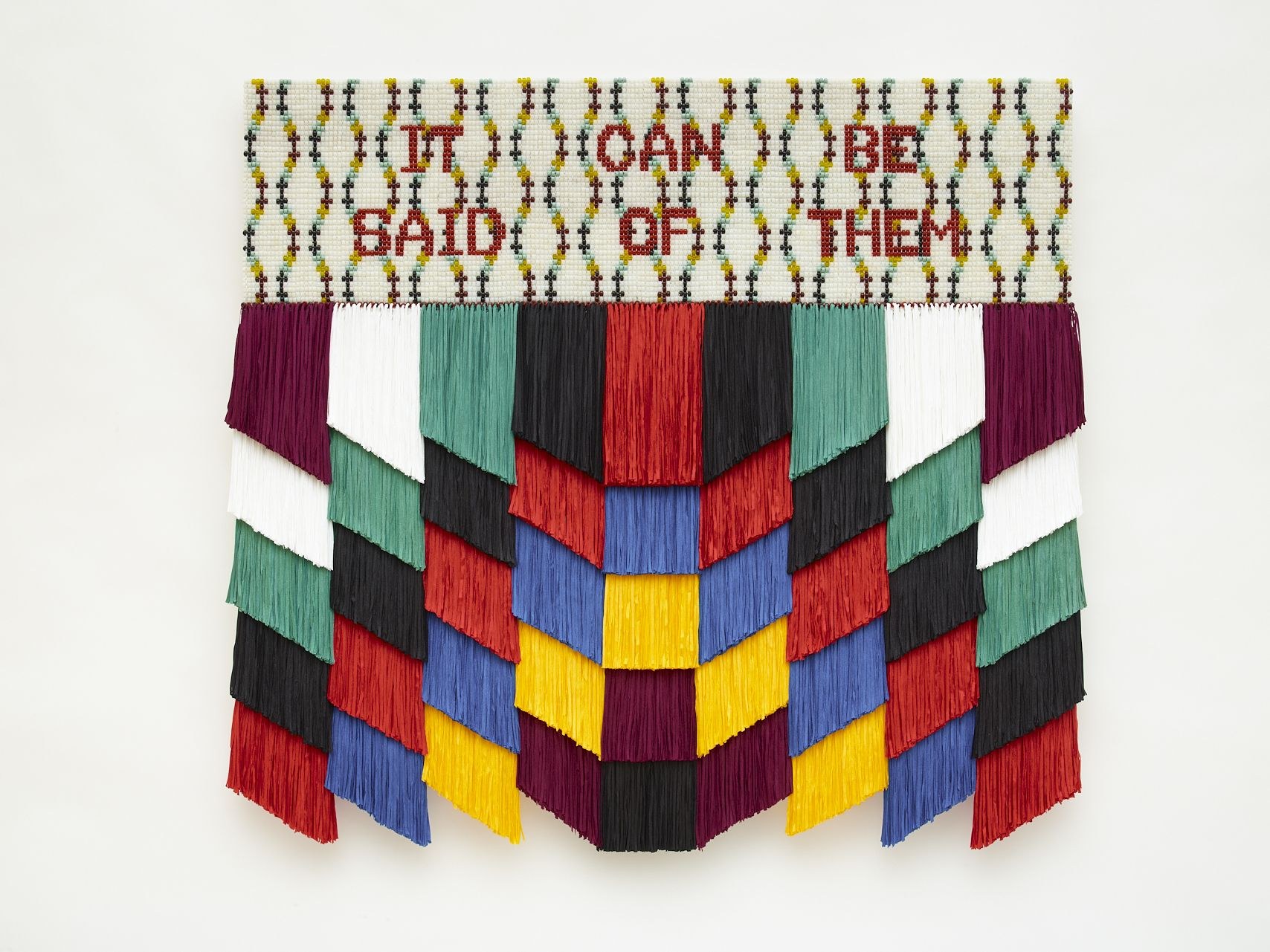
Jeffrey Gibson, “IT CAN BE SAID OF THEM,” 2020. Glass beads, artificial sinew, acrylic felt, nylon thread, nylon fringe, cotton canvas, wood panel, 50 x 56 x 3.5 inches. Image courtesy of the artist and Roberts Projects, Los Angeles, California.
At Roberts Projects in Culver City, a solo show by Jeffrey Gibson delights in meticulously crafted details. Part Choctaw and part Cherokee, Gibson calls upon craft traditions, like Iroquois beadwork, and infuses them with homages to pop-culture, music, and activism. Across the exhibition, lyrics from Tracy Chapman, Björk, and the Beatles are referenced in Gibson’s titles like “THE LOVE YOU GIVE IS THE LOVE YOU GET,” a meticulously beaded punching page that includes the Beatles lyrics carefully stitched across its patterned surface. The exhibition also celebrates the LGBTQI community by utilizing inclusive pronouns across the work. This week, I talked to Steve Chiotakis about the exhibition, Gibson’s blend of pop-culture and tradition, and the exhibition’s message.
Listen here


:strip_icc()/BHG_PTSN19720-33d9cd22f6ab49e6a21982e451321898.jpg)

More Stories
Fresh and Airy Interior Design Living Room Ideas for Summer
Where Art and Sound Converge: Exploring Fine Art Photography and Music Artist Portraiture
Cooking Chinese Cuisine with Ease Using Jackery Solar Generator 5000 Plus